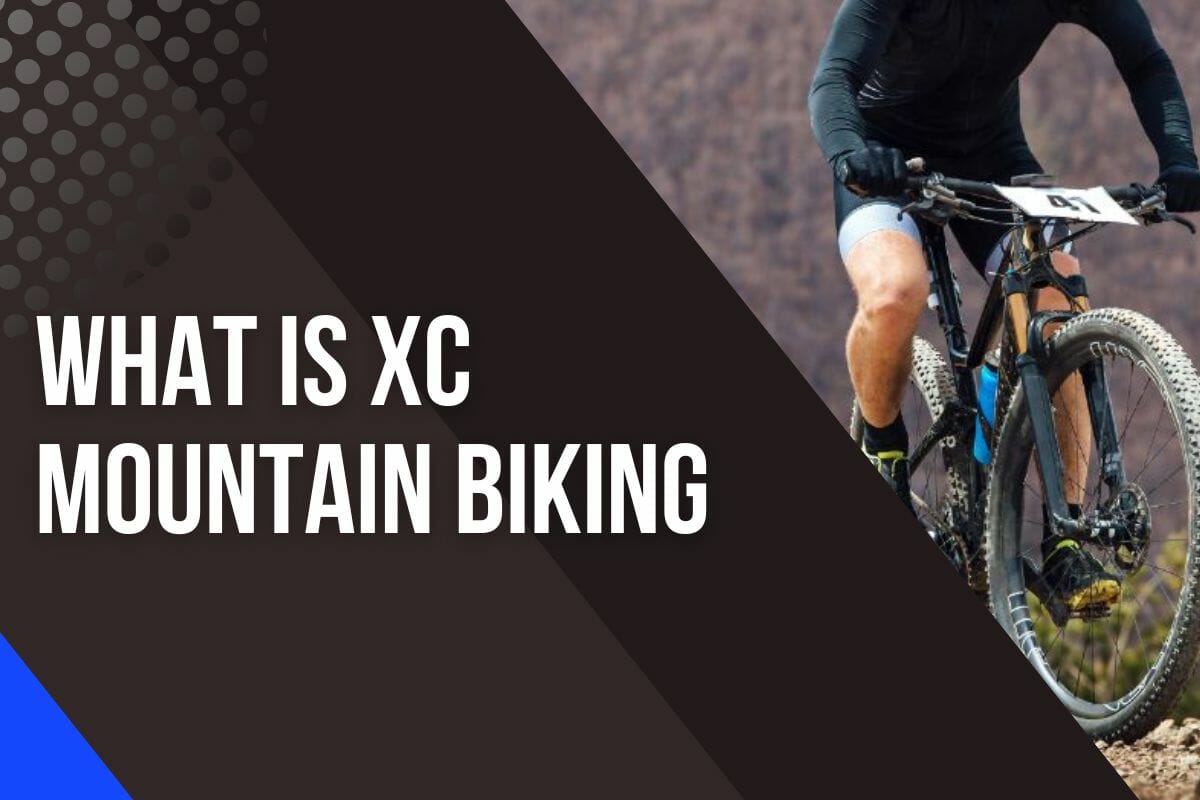What Is XC Mountain Biking? Unleashing Your Inner Adventurer

Have you ever heard of XC mountain biking? If you’re a fan of cycling, you might be familiar with the term.
But for those who are new to the sport, XC mountain biking might sound like a foreign concept.
XC stands for cross-country, a discipline in mountain biking beside enduro that involves racing or riding on off-road trails. It’s a thrilling and challenging sport that requires technical skills and endurance.
Now, we’ll dive deeper into what XC mountain biking is, what kind of equipment you need, and how you can get started.
What Precisely Is XC Mountain Biking?
Cross-country (XC) mountain biking is a form of mountain biking that emphasizes endurance and distance over technical terrain challenges.
Unlike other types of mountain biking that are quite dangerous and might focus more on technical obstacles and extreme terrain, XC mountain biking are more focused on the trails’ length and difficulty in completing them at a quick pace.
XC paths and trails tend to be smoother and more navigable, with fewer obstacles in the way.
The race track consists of hills to climb, slopes to descend, and some flatter sections too. The lap length varies from race to race, but it’s usually around 4 to 5km per lap.
When it comes to racing, the first person to cross the finish line wins. The number of laps you’ll need to complete depends on your age and experience.
Elite riders will do the most laps, which is usually around six to eight laps.
The entire race can take up to 90 minutes. On the other hand, if you’re a beginner or a younger rider, you’ll do fewer laps, and the race will last anywhere from 30 to 80 minutes.
What Are The Types of XC Races?
There are several different types of XC races, each with its own unique format and challenges.
The main differences between these types of XC races are primarily determined by race length, terrain, and format.
Here are some of the most popular types of XC races and what makes them different:
Cross Country Olympic (XCO)
This is the most commonly known XC race format. It involves a multi-lap race around a short course of typically 5 to 6 km in length.
The course can be quite technical with uphill and downhill sections, as well as obstacles such as rock gardens and drop-offs. The winner is usually determined by the fastest finishing time.
Cross Country Eliminator (XCE)
This is an elimination-style race format that involves multiple short laps of around 600 meters on a technical circuit that consists of berms, jumps, and obstacles.
The race is conducted head-to-head with several riders, and the person with the lowest finish time in each heat advances to the next round. The top two riders from the final round compete for the win.
Cross Country Marathon (XCM)
This is a long-distance XC race that can range anywhere from 50 to 100 km in length.
Unlike the XCO format, XCM races are usually a single-loop course that covers varying terrain like rolling hills, rocky descents, and steep climbs.
These races require a different level of endurance and fitness, with competitors needing to pace themselves to complete the course.

Cross Country Short Track (XCC)
This exciting race takes place the day before the XCO race and consists of a 1km to 1.5km circuit course that lasts between 20 and 25 minutes.
On average, racers will zoom through six to eight laps, pushing their skills to the limit.
And get this – the start grid order is based on the previous XCC race performance.
The circuit itself is usually a mix of the XCO start/finish straight and other parts of the course, but it can also be completely separate.
What Trails and Paths Do XC Riders Use?
Typically, cross-country riders use trails and paths that are twisty, hilly, and sometimes feature occasional jumps.
These kinds of trail provide an opportunity for riders to test their maneuvering skills.
On these trails, cross-country riders can practice quick turns, jumps, and drops that require speed and precision.

Hilly trails offer the challenge of steep climbs, descents, and rolling sections that help develop the rider’s speed and endurance.
The inclusion of occasional jumps enables cross-country riders to test their jumping ability, giving them an adrenaline rush and the confidence to take on more intense terrain.
Where To Find XC Races Near You?
If you’re looking to participate in XC races near you, there are various ways to find them. One of the best places to start is by checking out the USA Cycling, British Cycling, or your local cycling organization’s website.
Here, you can filter the location and type of race you’re interested in and get a list of upcoming races that match your preferences.
However, not all races may be listed on the website. Smaller, local races may have their own websites or social media pages, so conducting a quick search for events in your area may also be helpful.
What Bike Should I Use For Cross-Country Racing?
Entry-level mountain bikes are usually based on the standard cross-country bike design, so if you already have one of those, it can make things a lot easier.
Most of these bikes feature front suspension, allowing you to effortlessly navigate through tough terrain with ease.
Also, look for a frame material that is lightweight yet durable—aluminum is often the preferred choice for most riders due to its versatility and strength.
Two key factors that affect your choice of the bike include the type of suspension:
Hardtail vs full-suspension
Below, we’ll explore these categories in more detail and help you make an informed decision on which type of bike is best suited to your needs.
Hardtail vs Full-suspension
Riders who prioritize speed and efficiency may prefer a hardtail, while those who ride on technical terrain and prioritize comfort may opt for a full-suspension bike.
A hardtail mountain bike, as the name suggests, has a rigid frame with no rear suspension. The benefit of a hardtail is that it is typically lighter in weight and requires less maintenance compared to a full-suspension bike.
Hardtails are also more efficient on flat terrain, making them a great choice for riders who prioritize speed and distance over technical terrain.

On the other hand, full-suspension mountain bikes are designed with both front and rear suspension. This added suspension absorbs shock on technical trails, providing a smoother ride and better traction on rougher terrain.
However, full-suspension bikes are typically heavier and require more maintenance than hardtails due to the added moving parts.
Cross Country Bikes Cost
The price range can vary significantly depending on factors such as the frame material, suspension, and wheel size.
At the lower end of the spectrum, one can expect to pay around $500 for an entry-level hardtail cross-country bike.
On the other hand, high-end cross-country bikes, such as Trek’s XC bikes, with all the bells and whistles can cost upwards of $10,000.
While many riders might think they need to spend big to get a good cross-country bike, there are actually many excellent options available at a more reasonable price point.
For example, the Cannondale Trail 5 provides excellent value for money with its solid build quality and easy handling.
For those looking for more affordable cross-country bikes to get started, options ranging from $750 to $2,000 are often well-suited to beginners. These bikes typically feature a hardtail design with a suspension fork and basic components.
What Other Equipment And Accessories Do You Need?
Once you’ve picked the perfect bike, it’s time to invest in some basic safety gear.
What Else Do You Need For Cross-Country Racing?
When it comes to cross-country racing, there are a few additional things you’ll need to be prepared for and have on hand.
In addition to your XC mountain bike, you’ll want to make sure you have race spares ready in case of any mechanical issues during the race.
It’s also important to have a racing license to ensure you are eligible to compete in sanctioned races. Let’s take a closer look at what these entail.
Race Spares
When it comes to competing in cross-country races, having the necessary race spares can make all the difference.
While you can’t necessarily prepare for every potential issue, being equipped with a travel-size tool kit or saddle bag can help you handle minor mechanical issues that may arise during the race.
This should include a few basic tools, such as a multi-tool, tire levers, and a chain tool.
Another important piece of equipment to bring along is a CO2 canister or mini-pump.

These can be a lifesaver in case of a slow puncture, allowing you to quickly inflate your tire and get back in the race.
It’s important to know how to use these tools before race day, so take some time to practice inflating tires using a CO2 canister or mini-pump.
Racing Licence
If you’re considering entering XC MTB races, it’s important to understand the requirements for obtaining a racing license.
A racing license is required for official federation-organized events and serves as proof of your fitness to compete.
The requirements for obtaining a racing license may vary between different federations but generally involve completing a competency test and paying an annual fee.
My Verdict
XC mountain biking is a challenging and rewarding sport that requires a combination of physical fitness, technical skill, and mental toughness.
The best thing is, it’s accessible even to beginners.
So if you’re looking for a new adventure or a way to challenge yourself, give XC mountain biking a try.
Ready to hit the trails? Check out our guide to essential mountain biking gear and get started today!





